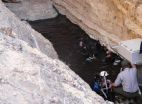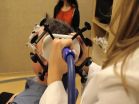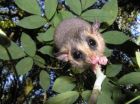(Press-News.org) RENO, Nev. – Climate change is hurting reproduction of the endangered Devils Hole pupfish, threatening the survival of this rare species that has numbered as few as 35 individuals, new research by the University of Nevada, Reno and Desert Research Institute shows.
Scientists report that geothermal water on a small shelf near the surface of an isolated cavern in the Nevada desert where the pupfish live is heating up as a result of climate change and is likely to continue heating to dangerous levels.
The hotter water, which now reaches more than 93 degrees, has shortened by one week the amount of time pupfish larvae have to hatch during the optimal recruitment periods. The recruitment period is the 10 weeks during which water temperatures are conducive to egg hatching and sufficient food is available to sustain the newly hatched larvae. This decrease contributed to the decline of the adult pupfish population, according to a scientific paper published in Water Resources Research, a journal of the American Geophysical Union.
"Climate change is making it harder for the Devils Hole pupfish to survive and has most likely contributed to the decline we have seen," said Mark Hausner, a hydrologist at the Desert Research Institute in Las Vegas, Nev., and lead author of the paper, "Life in a Fishbowl: Prospects for the endangered Devils Hole pupfish (Cyprinodon diabolis) in a changing climate."
Devils Hole, in the Mojave Desert, will also likely become less hospitable to the pupfish as climate change continues to warm the planet, he said. The new research found that increasing temperatures will likely reduce the pupfish's optimal recruitment period by another two weeks by mid-century. Higher temperatures could also affect the availability of food for young pupfish, leading to fewer adult fish.
"There is no question that the temperature is going to rise on the shallow shelf, and there is no question that the fish are going to be affected," said Scott Tyler, lead scientist in the project, co-author of the paper and a professor of hydrological sciences at the University of Nevada, Reno.
"While the population of the pupfish has declined, we are hoping they are in a period of recovery," Kevin Wilson, aquatic ecologist and a member of the research team from the Pahrump Field Office of Death Valley National Park, said. "Climate change is threatening the already small population size."
Devils Hole is a water-filled limestone cavern in the Ash Meadows National Wildlife Refuge, a detached unit of Death Valley National Park. It is an extreme environment, with water temperatures and dissolved oxygen concentrations near their lethal limits for most fish.
The iridescent blue, one-inch-long pupfish have lived in the top 80 feet of the water-filled cavern for more than 10,000 years.
There are now 92 Devils Hole pupfish observed living in the geothermal pool. The population, which fluctuates throughout the year, is down from 171 fish a decade ago (according to seasonal counts). The population is down from 553 fish when the population counts began in 1972, according to the National Park Service.
"This is a fish that does live in a fishbowl, an incredibly hostile fishbowl, and you can't move the fishbowl," Tyler said. "This is a species that can't adapt or change or leave to go to a better environment, though it's most likely gone through tremendous genetic bottlenecks in its more than 10,000 years of evolution."
Tyler and his team, with grants from the National Park Service, Nevada Department of Wildlife and the Death Valley Natural History Association, used fiber-optic cable distributed temperature-sensing equipment, pioneered by Tyler, to monitor temperature changes in the more than 400-foot deep geothermal fissure in the desert. They used current and historic data to create a numerical model, using the same equations used in fluid dynamics and aerodynamics for designing Formula-one race cars and airplane wings, to chart thermal mixing of the water within the aquifer.
The scientists combined climate projections, models of water circulation in the deep, water-filled fissure, and food web ecology to understand how climate change could affect the ecosystem within the pool. The model estimated optimal pupfish spawning periods based on projections about how much the environment will change and how much food will be available under different climate scenarios.
"The techniques used to model the impacts of climate change for the Devils Hole pupfish can be applied to other species in other desert locations to see how they might respond to the changing climate," Tyler said.
INFORMATION:
The research team includes Kevin Wilson and Bailey Gaines of the Pahrump Field Office of Death Valley National Park; Francisco Suárez from the Pontifical Catholic University of Chile; and Gary Scoppettone of the Western Fisheries Research Center of the United States Geological Survey. The American Geophysical Union posted a similar story about the research on their GeoSpace blog at on the AGU Blogosphere at http://blogs.agu.org/geospace/2014/08/26/heating-fishbowl-climate-change-threatens-endangered-devils-hole-pupfish/.
Founded in 1874 as Nevada's land-grant university, the University of Nevada, Reno ranks in the top tier of best national universities. With more than 19,000 students, the University is driven to contribute a culture of student success, world-improving research and outreach that enhances communities and business. Part of the Nevada System of Higher Education, the University has the system's largest research program and is home to the state's medical school. Bringing outreach and education programs to all Nevada counties and home to one of the largest study-abroad consortiums, the University extends across the state and around the world. For more information, visit http://www.unr.edu.
Climate change puts endangered Devils Hole pupfish at risk of extinction
University of Nevada, Reno and Desert Research Institute research shows rare fish struggling to survive
2014-08-28
ELSE PRESS RELEASES FROM THIS DATE:
Deadly remedy: Warning issued about Chinese herbal medicine
2014-08-28
A herbal preparation prescribed by a Chinese herbal medication practitioner in Melbourne for back pain resulted in life-threatening heart changes, prompting a team of intensive care and emergency physicians to call for appropriate patient education by practitioners who prescribe complementary medications.
Writing in Emergency Medicine Australasia, the journal of the Australasian College for Emergency Medicine, emergency medicine trainees Dr Angelly Martinez and Dr Nicky Dobos from the Intensive Care Unit at the Royal Melbourne Hospital and emergency medicine trainee Dr ...
Are cigarette substitutes a safe alternative? It depends on user habits
2014-08-28
CORAL GABLES, Fla (Aug. 26, 2014)-- Cigarette smoking kills approximately 440,000 Americans each year, according to the Centers for Disease Control and Protection. It's the leading cause of preventable death worldwide. In order to overcome this addiction, many people resort to nicotine replacement therapies.
A recent literature review study by researchers at the University of Miami (UM) suggest that small dosages of nicotine found in cigarette substitutes could be harmful to human musculoskeletal system, due to overuse. The findings are reported in the Global Journal ...
From bite site to brain: How rabies virus hijacks and speeds up transport in nerve cells
2014-08-28
Rabies (and rabies virus, its causative agent) is usually transmitted through the bite of an infected animal into muscle tissue of the new host. From there, the virus travels all the way to the brain where it multiplies and causes the usually fatal disease. An article published on August 28th in PLOS Pathogens sheds light on how the virus hijacks the transport system in nerve cells to reach the brain with maximal speed and efficiency.
Pathogens that travel in the blood can spread throughout the body without much effort, courtesy of the heart's pumping action. Those traveling ...
Genomic sequencing reveals mutations, insights into 2014 Ebola outbreak
2014-08-28
In response to an ongoing, unprecedented outbreak of Ebola virus disease (EVD) in West Africa, a team of researchers from the Broad Institute and Harvard University, in collaboration with the Sierra Leone Ministry of Health and Sanitation and researchers across institutions and continents, has rapidly sequenced and analyzed more than 99 Ebola virus genomes. Their findings could have important implications for rapid field diagnostic tests. The team reports its results online in the journal Science.
For the current study, researchers sequenced 99 Ebola virus genomes collected ...
Radio telescopes settle controversy over distance to Pleiades
2014-08-28
Astronomers have used a worldwide network of radio telescopes to resolve a controversy over the distance to a famous star cluster -- a controversy that posed a potential challenge to scientists' basic understanding of how stars form and evolve. The new work shows that the measurement made by a cosmic-mapping research satellite was wrong.
The astronomers studied the Pleiades, the famous "Seven Sisters" star cluster in the constellation Taurus, easily seen in the winter sky. The cluster includes hundreds of young, hot stars formed about 100 million years ago. As a nearby ...
New research reveals how wild rabbits were genetically transformed into tame rabbits
2014-08-28
The genetic changes that transformed wild animals into domesticated forms have long been a mystery. An international team of scientists has now made a breakthrough by showing that many genes controlling the development of the brain and the nervous system were particularly important for rabbit domestication. The study is published today in Science and gives answers to many genetic questions.
The domestication of animals and plants, a prerequisite for the development of agriculture, is one of the most important technological revolutions during human history. Domestication ...
Electric current to brain boosts memory
2014-08-28
VIDEO:
Stimulating a region in the brain with non-invasive electrical current using magnetic pulses (Transcranial Magnetic Stimulation) improves memory, reports a new Northwestern Medicine study in Science. The discovery opens...
Click here for more information.
CHICAGO --- Stimulating a particular region in the brain via non-invasive delivery of electrical current using magnetic pulses, called Transcranial Magnetic Stimulation, improves memory, reports a new Northwestern Medicine® ...
Less than $200 million would conserve precious Atlantic Forest in Brazil, say researchers
2014-08-28
Brazil could conserve its valuable Atlantic Forest by investing just 0.01 per cent of its annual GDP, according to a new study.
The Atlantic Forest (Mata Atlântica) is one of the most important and threatened biodiversity hotspots in the world, containing the only living examples of nearly 10,000 species of plant and more bird species than all of Europe.
Situated along the Atlantic coast of Brazil, it once covered an area of nearly 1.5 million square kilometres. Today, the forest is home to more than 130 million people and it covers only 160,000 km2, because of deforestation. ...
Home is where the microbes are
2014-08-28
A person's home is their castle, and they populate it with their own subjects: millions and millions of bacteria.
A study published today in Science provides a detailed analysis of the microbes that live in houses and apartments. The study was conducted by researchers from the U.S. Department of Energy's Argonne National Laboratory and the University of Chicago.
The results shed light on the complicated interaction between humans and the microbes that live on and around us. Mounting evidence suggests that these microscopic, teeming communities play a role in human ...
New DNA study unravels the settlement history of the New World Arctic
2014-08-28
We know people have lived in the New World Arctic for about 5,000 years. Archaeological evidence clearly shows that a variety of cultures survived the harsh climate in Alaska, Canada and Greenland for thousands of years. Despite this, there are several unanswered questions about these people: Where did they come from? Did they come in several waves? When did they arrive? Who are their descendants? And who can call themselves the indigenous peoples of the Arctic? We can now answer some of these questions, thanks to a comprehensive DNA study of current and former inhabitants ...
LAST 30 PRESS RELEASES:
Dynamically reconfigurable topological routing in nonlinear photonic systems
Crystallographic engineering enables fast low‑temperature ion transport of TiNb2O7 for cold‑region lithium‑ion batteries
Ultrafast sulfur redox dynamics enabled by a PPy@N‑TiO2 Z‑scheme heterojunction photoelectrode for photo‑assisted lithium–sulfur batteries
Optimized biochar use could cut China’s cropland nitrous oxide emissions by up to half
Neural progesterone receptors link ovulation and sexual receptivity in medaka
A new Japanese study investigates how tariff policies influence long-run economic growth
Mental trauma succeeds 1 in 7 dog related injuries, claims data suggest
Breastfeeding may lower mums’ later life depression/anxiety risks for up to 10 years after pregnancy
Study finds more than a quarter of adults worldwide could benefit from GLP-1 medications for weight loss
Hobbies don’t just improve personal lives, they can boost workplace creativity too
Study shows federal safety metric inappropriately penalizes hospitals for lifesaving stroke procedures
Improving sleep isn’t enough: researchers highlight daytime function as key to assessing insomnia treatments
Rice Brain Institute awards first seed grants to jump-start collaborative brain health research
Personalizing cancer treatments significantly improve outcome success
UW researchers analyzed which anthologized writers and books get checked out the most from Seattle Public Library
Study finds food waste compost less effective than potting mix alone
UCLA receives $7.3 million for wide-ranging cannabis research
Why this little-known birth control option deserves more attention
Johns Hopkins-led team creates first map of nerve circuitry in bone, identifies key signals for bone repair
UC Irvine astronomers spot largest known stream of super-heated gas in the universe
Research shows how immune system reacts to pig kidney transplants in living patients
Dark stars could help solve three pressing puzzles of the high-redshift universe
Manganese gets its moment as a potential fuel cell catalyst
“Gifted word learner” dogs can pick up new words by overhearing their owners’ talk
More data, more sharing can help avoid misinterpreting “smoking gun” signals in topological physics
An illegal fentanyl supply shock may have contributed to a dramatic decline in deaths
Some dogs can learn new words by eavesdropping on their owners
Scientists trace facial gestures back to their source. before a smile appears, the brain has already decided
Is “Smoking Gun” evidence enough to prove scientific discovery?
Scientists find microbes enhance the benefits of trees by removing greenhouse gases
[Press-News.org] Climate change puts endangered Devils Hole pupfish at risk of extinctionUniversity of Nevada, Reno and Desert Research Institute research shows rare fish struggling to survive



